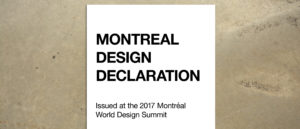
On 24 October 2017, representatives of the international community of designers, architects, planners and landscape architects signed the Montreal Design Declaration. The Declaration proclaims the potential of design to achieve global economic, social, environmental and cultural objectives and includes a dramatic call to action to professionals, educators and governments as well as a list of proposed projects.
The Montreal Design Declaration is a milestone marking the launch of a global collaborative effort to utilise the potential of design for the benefit of all, and concludes: “All people deserve to live in a well-designed world.“
—
The first Design Summit Meeting (DSM) marks the first international convening of the design community, across a broad spectrum of design disciplines, together with a strong array of international organisations, with cultural, economic, environmental and social perspectives. The design organisations present represent hundreds of thousands of designers from around the globe. The international bodies represent governmental, IGOs, NGOs and private and civil sectors of society worldwide.
Thanking the organisers of the World Design Summit for having convened this meeting, we have come together,
To express a shared view of the crucial role of design and the great responsibilities of designers; and
To affirm the fundamental role of design in creating and shaping the world around us, now and in the future.
We, the undersigned international representatives of professional designers, architects, urban planners, landscape architects and other design-related disciplines,
In the presence of international organisations representing and relating to public, private and civil sectors of society concerned with design and or impacted by design;
Cognisant of the diverse range of contexts, both formal and informal, where design has an impact;
Mindful of the immeasurable value of local and traditional knowledge for appropriate and innovative design solutions;
Sentient of the demand of communities, large or small, local or global, for decent living conditions and which design can help address;
Recognise the need for strategic leadership on design matters at local, regional, national and international levels and with this, the need for governance models, political agendas and policy to take design into account;
Recognise the need for sufficient fiscal and human resources and capacity;
Acknowledge the intrinsic capacity of design to serve as an agent of change and a source of creative transformation;
Acknowledge the fundamental and critical role of design to create a world that is environmentally sustainable, economically viable, socially equitable, and culturally diverse;
And confirm the value of working in a collaborative, holistic and integrated way to foster design of common benefit.
VALUE OF DESIGN
DESIGN IS the application of intent: the process through which we create the material, spatial, visual and experiential environments in a world made ever more malleable by advances in technology and materials, and increasingly vulnerable to the effects of unleashed global development.
Design is a driver of innovation and competition, growth and development, efficiency and prosperity.
Design is an agent for sustainable solutions created for people and supporting the planet on which we rely.
Design expresses culture. Designers have a particularly potent role in making, protecting, nourishing, enhancing and celebrating cultural heritage and diversity in the face of globalisation.
Design adds value to technology. Through consideration of human perspective and interface, and by focusing on individual interaction first, design bridges technology with human needs.
Design facilitates change. Design enables all aspects of society, public and private, governmental and non- governmental, civil society and individual citizen, to transition through change (i.e. austerity, demographic changes, shifts in services) to deliver a better quality of life for all citizens.
Design introduces intelligence to cities as a foundation for better communications, improved environments, enhanced quality of life and more prosperous local communities.
Design addresses resiliency and manages risk through comprehensive research, robust methodology, prototyping and consideration of life-cycle consequences.
Design fosters development of SMEs in general and the creative industries in particular.
DESIGNERS ARE professionals, who, by education, outlook and experience, are capable of developing new, interdisciplinary solutions to improve quality of life.
CALL TO ACTION
Recognising that design leadership is a key to the delivery of sustainable solutions and implementation of design methodologies that contribute to a more sustainable future,
We seek to collaborate with and embrace the language of governments, businesses, NGOs and communities throughout the world,
Calling for:
Design Advocacy: more effective communication of the meaning and value of design and understanding of the design process.
Development of Design Metrics: collection of data and establishment of effective measures to better enable the evaluation of the impact of design, thus demonstrating the strategic value of design within organisations and businesses and in serving the public good.
Development of Design Policies: to be applied at the local, regional, national and international levels.
Development of Design Standards: support of professional design communities, the development of design industry infrastructures and development of standards, codes, covenants, best practices, legal protections and certification programs.
Enhancement of Design Education: support for educational institutions, methods and processes specific to design education, design research and lifelong learning and capacity building for designers.
Responsive Design: design that is responsive to the degradation of the physical, social and cultural environment, and natural ecosystems and the threats and risks caused by global change, industrialisation, rapid urbanisation and unfettered consumption, profoundly affecting quality of life and impacting sustainable economic growth.
Responsible Design: recognition, by designers, of the impact resulting from their practice, whereby designers must be conscious of their enormous capacity to be constructive, as well as destructive, in the interventions they make. Designers share in the responsibility of refocusing from human consumption to the enhancement of human life.
Vigilant Design: in a world increasingly impacted by machine learning and artificial intelligence, designers must help ensure that the impact of algorithms and technology are ethical and inclusive of social, cultural and ethnic diversity.
Recognition of Design: by leaders, decision-makers and influencers across all sectors of society, of the value of design, and need to foster and implement design for the greater common good.
We therefore, express our intent:
To work in concert, collectively, in groups and as individual entities, and with additional stakeholders, to establish an ongoing, structured process of collaboration, as manifested here in this Declaration, including future World Design Summit Meetings;
To collaborate with other efforts with shared objectives: including the UN 2030 Sustainable Development Goals, New Urban Agenda, Paris Climate Accord and the UNESCO Convention on the Protection and Promotion of the Diversity of Cultural Expressions, and others;
To develop a world design agenda, whereby this Declaration is a first invitation to join in common cause to support design;
To collectively initiate projects fostering and advancing the role, responsibility and value of design;
To mandate the Design Summit Meeting Steering Committee, with the active collaboration of Summit Meeting participants, to develop the mechanisms required to ensure continuation of the process initiated by this Declaration, drafted by and for the international design community, to achieve the desired outcomes. The proposed mechanisms will be submitted to the signers of this Declaration for approval;
To influence and support decision making, locally and globally, on policy and resources;
To give design an effective, united voice;
To inspire designers—too long the servants of producers—to better serve humanity as the ambassadors of the end-users: the citizens of the world.
All people deserve to live in a well-designed world.
—
Issued at the 2017 Montréal World Design Summit
Adopted: 24 October 2017, Montréal (Canada)
Updated: 05 April 2018
